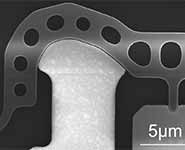Dr Dinesh Pamunuwa, Reader in Microelectronics in the Department of Electrical and Electronic Engineering at the University of Bristol and who is in charge of the project’s communication, said: “NEM relays have practically zero leakage, an abrupt turn-on transient and a high on-current, and can also be integrated with CMOS at the die or wafer level. This makes them promising candidates for digital logic implementation in ultra-low power applications.
“By building a functioning NEM relay-based processor we would go full circle by using electro-mechanical switches as the basic building block some 200 years after Babbage proposed his original fully mechanical calculator.”
One of the first fully electronic general purpose computers, the vacuum tube based ENIAC (Electronic Numerical Integrator and Calculator) consumed 200 kW of power and occupied an entire room. Advancements in solid-state transistor technology since then have allowed continuous shrinking and reduction of power while at the same time allowing more and more functionality, which has led to the digital revolution.
Due to fundamental material and structure related constraints however, transistors have a firm ceiling on energy efficiency, which limits their scope in ultra-low power applications.
NEMIAC proposes a solution based on NEM relays.
Electro-mechanical computing played an important role in history with the Automatic Sequence Controlled Calculator (Harvard Mark I) built by IBM in 1946 representing a milestone in general purpose computing.
The long-term potential of the NEM logic technology is to enable future smart systems that consume very little energy, and coupled with energy harvesting realise the emergence of a new class of applications that essentially run forever - autonomously, remotely and without a battery.
This research supports IBM's "smarter cities" vision, where ubiquitous sensing and Insitu processing and control underpin the essential infrastructure of a city, including transport, energy and utilities, healthcare, retail and safety. Building global intelligence into such systems of systems has the potential to transform the socio-economic wellbeing of the European citizen, from reducing traffic congestion and carbon percentages to smart power grids to improved water and air quality monitoring.
The consortium taking part in the project includes IBM Zurich, STMicroelectronics, Royal Institute of Technology Sweden (KTH), University of Bristol, École Polytechnique Fédérale de Lausanne (EPFL) and Lancaster University.
